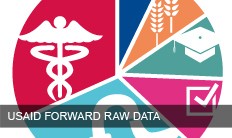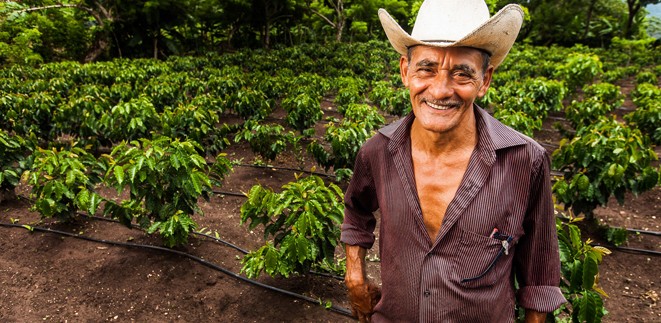
2014 USAID Forward Results
Data Tables
The eight data tables fall into three separate but mutually reinforcing principles that define good development work today. The goals and metrics are reflected in each table.
USAID Forward FY14 Presentation
Deliver results through strengthened capacity
- Focused strategic planning [MS Excel, 14kb]
- Improved decision-making. [MS Excel, 103kbB]
- Strengthen and retain best talent. [MS Excel, 168kb]
- Strengthen staff capacity. [MS Excel, 172kb]
Partner for sustainable development
- Strengthen local capacity. [MS Excel, 389kb]
- Scale up & leverage private resources. [MS Excel, 32kb]
- Maximize resources by leveraging commercial private capital. [MS Excel, 62kb]
Unlocking game-changing solutions
- Accelerate financial inclusion, improve transparency and catalyze private sector development. [MS Excel, 20kb]
7028 Reporting, July 2015
In September 2010, President Obama called for the elevation of development as a key pillar of America’s national security and foreign policy. This set forth a vision of an empowered and robust U.S. Agency for International Development that could lead the world in solving the greatest development challenges of our time and, ultimately, meet the goal of ending extreme poverty in the next generation.
To transform this vision into reality, USAID undertook an ambitious reform agenda called USAID Forward, an effort to strengthen the Agency by embracing new partnerships, investing in the catalytic role of innovation and demanding a relentless focus on results. Taken together, these reforms represent the best of American ideals abroad, while advancing the security and prosperity of Americans at home. In line with our commitment to transparency, we are releasing our fourth set of data detailing USAID’s results for 2014.
USAID Forward At a Glance
The reforms are focused on three main areas:
- Deliver results on a meaningful scale through a strengthened USAID. In order to maximize our impact with every development dollar, we have to pursue a more strategic, focused and results-oriented approach, from strengthening our policy and budget management to enacting a world-class evaluation policy.
- Promote sustainable development through high-impact partnerships and local solutions. In order to achieve long-term sustainable development, we have to support the institutions, private sector partners and civil society organizations that serve as engines of growth and progress for their own nations. USAID Forward embraces new models for public-private partnerships and increased investment directly to partner governments and local organizations.
- Identify and scale up innovative, breakthrough solutions to intractable development challenges. At USAID, we have a strong history of partnerships with the scientific community that helped pioneer some of the greatest successes in development to date. USAID Forward furthers this legacy by strengthening our work with scientists, researchers and universities, investing in new technologies to source and scale game-changing solutions, and supporting mobile solutions to dramatically expand opportunity.
Forward Progress
The Agency has made significant progress since USAID Forward was first announced in 2010, the same year as the release of the Presidential Policy Directive on Global Development and the first Quadrennial Diplomacy and Development Review (QDDR).
Deliver results on a meaningful scale through a strengthened USAID
- True to our commitment to strategic, performance-based planning, USAID has completed 58 of a total of 62 Country Development Cooperation Strategies to date, representing the majority of USAID Missions.
- Confirming our relentless focus on results, USAID Forward missions reported completing 178 evaluations, while overall USAID completed 224 evaluations worldwide in FY 2014. USAID staff used completed evaluations to inform decisions including designing follow-on projects, making mid-course corrections, developing country strategies, scaling-up projects, budget allocations and other related decisions. You can read and easily share these evaluations by accessing: https://dec.usaid.gov/dec/home/Default.aspx.
- Direct engagement is essential to achieving our local sustainable development objectives. Challenging circumstances in high-risk posts can limit our staff’s ability to directly engage with local partners. In some countries, regular staff turnover and security concerns that prevent travel to project sites impede the creation of strong, professional relationships with host-country counterparts. However, our Foreign Service Officers (FSOs) and Foreign Service Nationals (FSNs) strive to establish close, personal working relationships with local partners – government, civil society, and private sector. There was a modest increase this year in the percentage of staff who engaged directly with local partners from 62% in FY 13 to 66% in FY 14. USAID’s FSOs and FSNs are increasingly working directly with partners in planning, co-financing, co-creating, implementing, developing capacity, visiting project sites and evaluating the impact of assistance.
- Mentoring programs are an effective means through which FSNs and FSOs receive guidance and feedback from experienced staff on a range of issues from career development to leadership skills. Between FY 2013 and FY 2014, the number of FSOs and FSNs participating in formal mentoring programs decreased by 18% due to a reduction in the number of experienced employees serving as mentors and a decreasing number of missions with formal mentoring programs. In 2015, USAID will begin to track the number of FSOs and FSNs who are participating in both formal mentoring programs and informal mentoring on a quarterly basis. USAID’s Center for Professional Development will also establish a “Mentoring Hub” of best practices, case studies, and mentoring tools that will help missions strengthen their existing mentoring programs.
Promote sustainable development through high-impact partnerships and local solutions
- We are partnering directly with local governments, the private sector, civil society, and academia to ensure that local systems own, resource, and sustain the development results in which we invest. The global average of mission funds programmed through local systems has increased from 9.6% in FY 2010 to 16.9% in FY 2014. The Agency's leveling on this metric is a result of a decrease in the overall levels of direct obligations in Afghanistan and the limited absorptive capacity of local governments in Pakistan. Excluding these countries, USAID continues to increase direct obligations from 12.3% in FY 2013 to 15.1% in FY 2014. Since 2010, we have doubled the amount of funding from $381 million to $862 million in FY 2014 provided to local civil society and private sector organizations. Our prudent and strategic approach to Local Solutions is yielding results, for example:
- 6,419 families from 199 communities in Peru are giving up illicit coca by planting more than 7,700 hectares of alternative crops, thanks to government-to-government assistance;
- a private pharmaceutical firm in Nepal is assuming the risk for developing, proofing, and commercializing a gel that reduces infant mortality by 34%; and,
- a significant reduction in the cost of procuring health commodities due to the strengthened capacities and internal controls of the Kenya Medical Supplies Agency.
- We have begun a critical shift in how we engage with the private sector and have substantially strengthened both our Development Credit Authority (DCA) and Public Private Partnerships (PPPs).
- In FY 2014, USAID remained committed to working with private sector partners, with Missions leveraging $250 million in private sector resources towards new Global Development Alliances, i.e. partnerships with at least 1:1 leverage of private sector resources. Across both new and ongoing PPPs, USAID is leveraging over $1 billion in combined private sector resources. In addition to these direct co-investments, USAID has also shifted towards a broader range of private sector engagement approaches, including large multi-stakeholder alliances such as Power Africa and the New Alliance for Food Security and Nutrition, for which USAID serves as a catalyst and convener for private sector investment.
- Since the launch of USAID Forward, the size and impact of USAID's DCA credit guarantees has nearly doubled – nearly as much private capital has been leveraged in the past three years during the USAID Forward period ($1.8b) as in DCA’s previous 12 years ($1.9b). In FY 2014 alone, USAID entered into 32 guarantees with 49 financial partners in 18 countries, leveraging over $769m in credit using just $25.7m in USAID funds.
Identify and scale up innovative, breakthrough solutions to intractable development challenges
- We are fostering a culture of innovation and using our convening power to test and scale breakthrough innovations to solve development challenges faster and cheaper. USAID’s U.S. Global Development Lab embodies this effort and seeks to increase the application of science, technology, innovation and partnerships to achieve, sustain and extend the Agency’s development impact. For example, we continue to expand digital financial services, which accelerate financial inclusion, help fight corruption and catalyze private sector development. In FY2014, at least 15 Missions pursued at least one activity related to digital finance and financial inclusion, 8 of which had enough engagement to qualify as a "Mobile Money Missions." We expect engagement in this game-changing solution to increase, with even more Missions planning to pursue related activities in FY2015.

Related Links







Comment
Make a general inquiry or suggest an improvement.